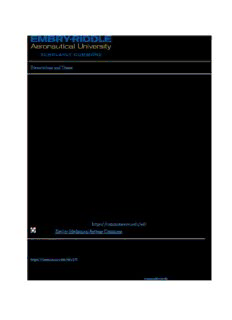
Energy Conservation By Intermittently Recirculating and Aerating an Aquaponics System with an PDF
Preview Energy Conservation By Intermittently Recirculating and Aerating an Aquaponics System with an
Dissertations and Theses 7-2014 EEnneerrggyy CCoonnsseerrvvaattiioonn BByy IInntteerrmmiitttteennttllyy RReecciirrccuullaattiinngg aanndd AAeerraattiinngg aann AAqquuaappoonniiccss SSyysstteemm wwiitthh aann AAiirrlliifftt Bjorg Magnea Olafs Embry-Riddle Aeronautical University - Daytona Beach Follow this and additional works at: https://commons.erau.edu/edt Part of the Electro-Mechanical Systems Commons SScchhoollaarrllyy CCoommmmoonnss CCiittaattiioonn Olafs, Bjorg Magnea, "Energy Conservation By Intermittently Recirculating and Aerating an Aquaponics System with an Airlift" (2014). Dissertations and Theses. 175. https://commons.erau.edu/edt/175 This Thesis - Open Access is brought to you for free and open access by Scholarly Commons. It has been accepted for inclusion in Dissertations and Theses by an authorized administrator of Scholarly Commons. For more information, please contact [email protected]. ENERGY CONSERVATION BY INTERMITTENTLY RECIRCULATING AND AERATING AN AQUAPONICS SYSTEM WITH AN AIRLIFT by Bjorg Magnea Olafs A Thesis Submitted to the College of Engineering, Mechanical Engineering Department in Partial Fulfillment of the Requirements for the Degree of Master of Science in Mechanical Engineering Embry-Riddle Aeronautical University Daytona Beach, Florida July 2014 Dedication I dedicate my work to my loving parents, Lara Kristjansdottir and Thorsteinn Olafs. All I have and will accomplish is only possible due to their endless love and support. Ég elska ykkur. iii Acknowledgements I extend my warmest thanks to the following people for their inspiration, guidance, patience, and support. I am forever thankful for my family and their endless support. I would also like to thank Ms. Tammie Radikopf for her support and encouragement throughout my thesis research period. I have truly enjoyed being a part of several extracurricular projects and I would like to thank Dr. Compere for welcoming me into his group of driven students. He has opened my eyes towards social responsibility and how I will be able to use my knowledge from my education to better lives and better the world. I appreciate greatly Dr. Fugler and his advisement throughout the years. Thank you for always making me feel welcome and all of the intellectual and interesting conversations. Lastly, I would like to thank Dr. Merkle for introducing me to aquaponics and the endless possibilities of improving current technologies. Thank you for accepting me as your first graduate thesis student, for your patience, and interest in seeing me succeed in my endeavors. iv Abstract Researcher: Bjorg Magnea Olafs Title: Energy Conservation By Intermittently Recirculating and Aerating an Aquaponics System with an Airlift Institution: Embry-Riddle Aeronautical University Degree: Master of Science in Mechanical Engineering Year: 2014 An airlift device providing aeration and circulation was designed to reduce electrical power requirements for aquaponics by eliminating the need for a water pump. The airlift performed better than predicted and achieved water flow rates of 10 L/min at 25 °C, in comparison to the theoretical design performance 2.65 L/min. Koi (Cyprinus carpio) and sweet basil (Ocimum basilicum) were cultured for five weeks in two identical aquaponics systems. The system was located indoors and consisted of a fish tank, a sump tank, and a soil-free growth media bed under artificial lighting. The total water volume in each system was 230 liters. Test conditions of intermittent vs. continuous aeration and recirculation were studied and growth rates of plants and fish were measured. Four week-long tests of intermittent aeration and circulation (50% on/50% off) showed net total bed growth rates per 1 KWh per day of 99.4%, while the continuous operated bed showed 50.3% growth per 1 KWh for the same period. The intermittently operated system showed 44.1% more growth for the same energy consumption. This suggests electrical power requirements for aquaponics aeration and recirculation may be reduced by as much as 75% with the use of an intermittent aeration and recirculation through an airlift. This suggests that intermittent v airlift technology may be useful for reducing energy costs, and increasing the feasibility of using renewable power in commercial aquaponics farms. vi Table of Contents Thesis Review Committee: ............................................................................................................. ii Dedication ...................................................................................................................................... iii Acknowledgements ........................................................................................................................ iv Abstract ........................................................................................................................................... v List of Tables .................................................................................................................................. x List of Figures ................................................................................................................................ xi Chapter I Introduction ................................................................................................................... 1 Significance of the Study .................................................................................. 1 Statement of the Problem .................................................................................. 2 Purpose Statement ............................................................................................. 3 Limitations ........................................................................................................ 4 Definitions of Terms ......................................................................................... 5 List of Acronyms .............................................................................................. 7 II Review of the Relevant Literature ................................................................................ 8 Introduction ....................................................................................................... 8 Energy Efficiency Techniques in Aquaponics Design ..................................... 9 Airlift for Water Transport .............................................................. 9 Optimum Conditions in Aquaponics Systems .............................. 10 vii Intermittent Aeration and Recirculation ....................................... 12 Renewable Energy Methods Suitable for Daytona Beach, Florida ................ 13 Summary ......................................................................................................... 15 Hypothesis ....................................................................................................... 16 III Methodology ............................................................................................................... 17 Research Approach ......................................................................................... 17 Design and Procedures .................................................................. 17 Apparatus and Materials ............................................................... 20 Solids Lifting Overflow ................................................................ 21 Airlift ............................................................................................. 22 Water and Air Pipe Flow .............................................................. 25 Conditions for Living Organisms ................................................. 26 The Experimental Setup in Pictures ................................................................ 32 Sample Sizes and Data Sources ...................................................................... 32 Data Collection Device ................................................................................... 33 Instrument Reliability ................................................................... 33 Instrument Validity ....................................................................... 34 IV Experimental Results .................................................................................................. 35 Data Tables and Graphs .................................................................................. 35 Power Saving Estimates: Water Pump vs. Air pump ..................................... 40 viii Conclusion ...................................................................................................... 41 V Discussion, Conclusions, and Recommendations ....................................................... 42 Discussions ..................................................................................................... 42 Airlift Design ................................................................................ 42 Plant Growth Stages ...................................................................... 43 Fish Growth .................................................................................. 43 Conclusions ..................................................................................................... 45 Airlift ............................................................................................. 45 Intermittent Aeration and Recirculation ....................................... 46 Energy Savings ............................................................................. 46 Recommendations ........................................................................................... 47 Recommendations for Practitioners .............................................. 47 Recommendations for Improving this Study ................................ 48 References ..................................................................................................................................... 49 Appendices A Bibliography ............................................................................................................... 51 B Formulas and Calculations .......................................................................................... 55 C Tables .......................................................................................................................... 76 D Figures ......................................................................................................................... 85 ix
Description: